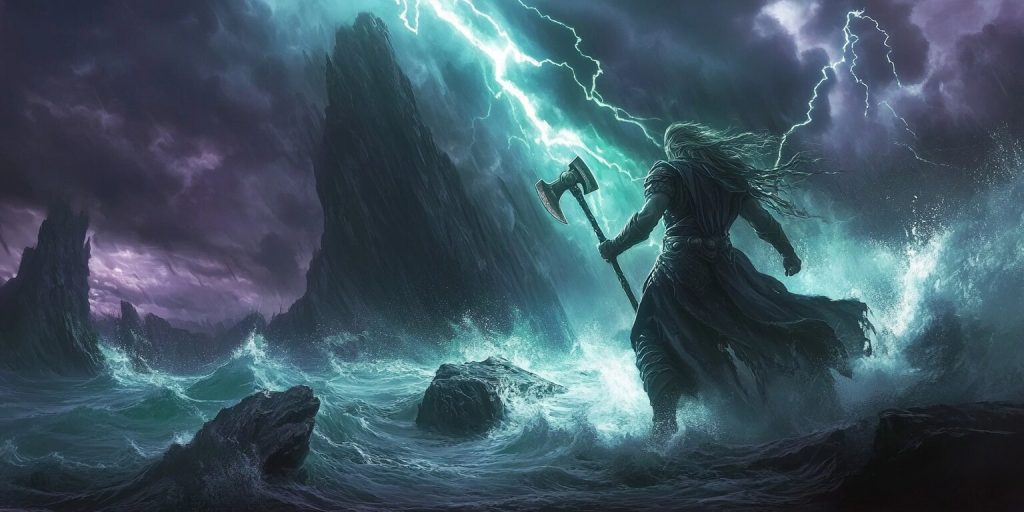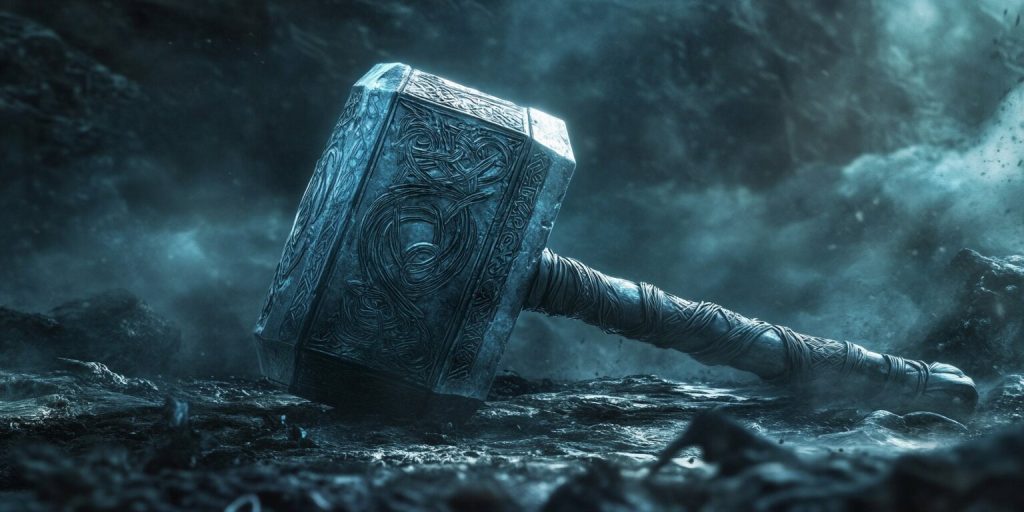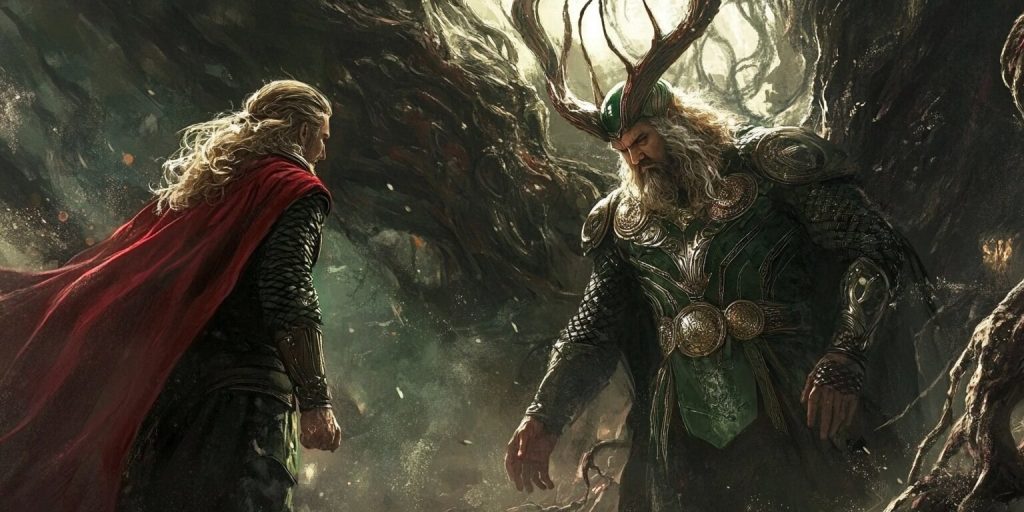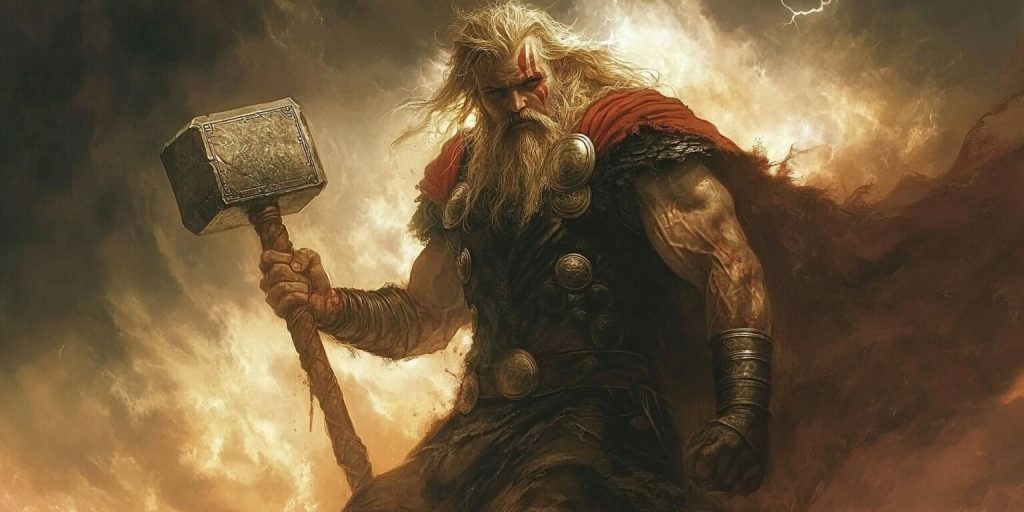Aesir Gods, Giants (Jötunn), Jormungand, Mjölnir (Thor’s Hammer), Norse Gods, Norse Mythology, Thor
What Are Thor’s Powers in Norse Mythology?
Thor is a famous god of thunder in Norse myths. He is known for his great powers and bravery. He is the son of Odin and a key figure in Norse stories.
Thor is famous for his mighty hammer, Mjölnir, and his power to call storms. His abilities are a big part of Viking culture and stories; his son Magni also reflects this legacy. We learn about Thor’s powers from books like “Norse Mythology: A Guide to Gods, Heroes, Rituals, and Beliefs” by John Lindow. This book helps us understand why Thor is so important in myths.
The Mighty Thor: Introduction to the Thunder God
Thor is a powerful god from the Norse religion. He is known for his strength and bravery. His red hair and beard make him look mighty, reminiscent of a Roman god.
He protects gods and humans from giants and evil forces. His strong look makes people fear and respect him.
Thor is the son of Odin, a key figure in Norse mythology. He controls thunder and lightning. He keeps order in a world filled with evil, embodying the qualities of a true sky god.
Historians like Olaus Magnus talk about Thor’s importance to the Germanic people. They saw him as a protector and a fierce warrior.
Over time, Thor has become more than just a myth. He stands for bravery and never giving up. His stories and traditions keep him alive as the ultimate thunder god.
Understanding Thor’s Role in Norse Mythology

Thor was a key figure in Norse mythology, seen as a protector and warrior. He was more than just strong; his role was crucial to the Norse people. Thor, the thunder god, was deeply linked to nature and protected Midgard, the human world.
Thor was a symbol of bravery and strength among the Norse gods. His stories show his power and his strong sense of justice. He had complex relationships with gods like Loki and Odin, showing how gods worked together and clashed.
The Vikings revered Thor, offering rituals and sacrifices to him. These acts were meant to bring good harvests and keep chaos away. Thor’s stories in the Prose Edda show how much the Norse admired him. Seeing Thor as a deity means understanding his role in myths and the culture that celebrates him.
What Are Thor’s Powers in Norse Mythology
Thor is a mighty Norse mythology god known for his amazing powers. He is famous for his strength and his special hammer, Mjölnir. This hammer is not just a tool; it’s a symbol of protection and good luck.
Thor is also known for his incredible fighting skills. He is a brave warrior who fights giants and other enemies. His strength and skills make him a hero in Norse stories.
So, is Thor the god of thunder? Let`s find out.
Mjölnir: The Legendary Hammer
Mjölnir is Thor’s special hammer, made by dwarven craftsmen. It symbolizes immense Thor Norse mythology powers and abilities. It can call forth lightning and thunder, showing Thor’s deep connection to nature. When Thor holds Mjölnir, storms accompany him, proving his huge power.
The hammer always returns to Thor’s hand, showing his unmatched strength and control. This shows how powerful he is, as he stands as a formidable figure in the pantheon of Old Norse gods.
Control Over Thunder and Lightning
Thor has legendary control over thunder. Stories tell of storms following him, showing his power over the weather. This power makes his enemies afraid and protects his people.
Thor uses thunder to protect Asgard and Midgard from danger, wielding Mjölnir against threats. He fights to protect his realms and everyone in them.
Physical Strength and Combat Skills
Thor is known for his huge strength in Norse stories. He is one of the strongest gods, able to beat giants and huge challenges. His fighting skills are top-notch, and he has gained from many battles.
Thor’s strength and fighting skills show his commitment to protecting his home and friends. He fights to keep the peace.
Thor’s Relationships with Other Norse Gods
Thor is a key figure in Norse mythology. He has strong bonds with many gods. His relationship with Odin, the All-Father, is filled with respect and expectation. As Odin’s son, Thor’s strength reflects his father’s power.
Thor and Loki have a complex relationship. They go on many adventures together. But Loki’s tricks often test their friendship. This shows how Thor values loyalty and justice.
Thor’s stories and relationships show themes of loyalty and power, particularly in his bond with Sif. These stories help us understand Thor’s character, the values of Norse mythology, and Thor’s fight with the giants. They give us a peek into the world of Norse gods.
The Significance of Thor’s Hammer in Viking Tradition
Thor’s hammer, Mjölnir, meant more than just myth to the Vikings. It was a key part of their identity and faith, touching many parts of their lives in daily activities and spiritual practices.

Cultural Impact of Mjölnir
Mjölnir was very important in Viking culture. Archaeologists found many of Thor’s hammer amulets. These showed its role in protecting and strengthening people.
It was also key in marriage ceremonies, often associated with the blessings of Sif. People used it to bless and wish for good luck, which shows how much Thor’s hammer meant to the Norse people.
Thor’s Hammer as Symbolism
Thor’s hammer had deep meaning in Viking culture. It was more than a tool; it symbolized protection against evil. It stood for the fight between order and chaos.
It showed the strength and moral courage of the Norse people. Raising the hammer in rituals showed two sides: protection in battles and a symbol of faith. This brought communities together with shared beliefs.
Legendary Battles: Thor vs. Giants
Thor, the mighty thunder god, is famous in Norse mythology for his battles against giants. These fights show his strength and bravery, particularly in Thor’s fight with the giants. They also highlight the deep stories from the Edda. The battle with Jörmungandr, the world serpent, is especially famous.
Thor’s Epic Fight with Jörmungandr
The fight between Thor and Jörmungandr is a key event in Norse stories. Jörmungandr, the Midgard Serpent, circles the Earth, challenging Thor. Their battle is more than just a test of strength. It’s a key moment that shows the fight between order and chaos.
At Ragnarök, the end of the world, Thor and Jörmungandr meet again. This final battle is full of tension and deep meaning. It shows Thor’s bravery in his fights against giants and emphasizes his role as the sky god.
Stories from the Edda
The Edda tells many exciting stories of Thor’s adventures. These stories show his battles with giants, proving he protects gods and humans. In one story, Thor quests to regain his hammer, Mjölnir, showcasing his powers and abilities.
These tales focus on Thor vs. Giants and show the rich culture and beliefs of the Norse people. They celebrate Thor’s heroic actions and strong will.
Thor and Loki: A Complex Relationship
In Norse mythology, the relationship between Thor and Loki is very complex. They share bravery, mischief, and betrayal. Thor is the strong thunder god, while Loki loves chaos and trickery.

Thor and Loki often go on adventures together. In the “Prose Edda,” Loki gets Thor into trouble with his tricks, showcasing the cleverness often found in Old Norse tales. For instance, during the quest for Mjölnir, Loki’s lies put Thor in danger.
This shows that Thor depends on Loki, even though Loki is untrustworthy. Their relationship is full of ups and downs.
Thor stands for order and strength, while Loki brings chaos. This mix makes their bond interesting. They have good times and bad, often because of Loki’s actions.
Loki’s betrayals lead to big events, especially during Ragnarok. The story of Thor and Loki shows how complex friendship can be. It shows that strong bonds can be as powerful as the gods they represent, especially in the context of Thor and his hammer.
The Legacy of Thor in Modern Culture
Thor has moved from ancient stories to today’s culture, showing his lasting charm. His story has changed thanks to books, movies, and comics, allowing people to see him in fresh ways.
Marvel Comics has greatly shaped Thor in today’s culture. They made Thor a superhero with traits we can relate to. He now stands for heroism, loyalty, and fighting against evil. These themes make him more than just a mythological figure.
- Marvel’s movies have made Thor more interesting, showing him real flaws while still highlighting Thor and his hammer.
- These stories have brought Thor to a new generation, showing his deep side.
- Thor’s story lives on in movies, TV shows, and comics.
Thor’s impact on pop culture is huge. He’s not just about strength anymore. He’s a topic for deep talks on being a man and finding your identity. This makes him more interesting and important to us.
Thor’s story shows he can change and stay relevant over time. He keeps drawing us in through different stories, both now and in the past.
Conclusion
Thor’s powers are a big part of Norse mythology and still inspire us today. His hammer, Mjölnir, shows his strength, his role in protecting gods and humans, and his title as the god of lightning and thunder. Thor is known for controlling thunder and lightning, making him a key figure in Norse stories.
Thor’s importance goes beyond old stories. He stands for the heroism we admire in history and today’s stories. His stories teach us about bravery, loyalty, and facing giants. They show how Thor’s complex character has kept his legend alive for everyone.
Looking into Thor’s stories, we see they’re more than just fun tales. They reflect our values and experiences. These stories make us think about the impact of Norse myths on today’s stories. They help us see the value of the Thunder God in history and popular culture, illustrating his significance as a god of war.

